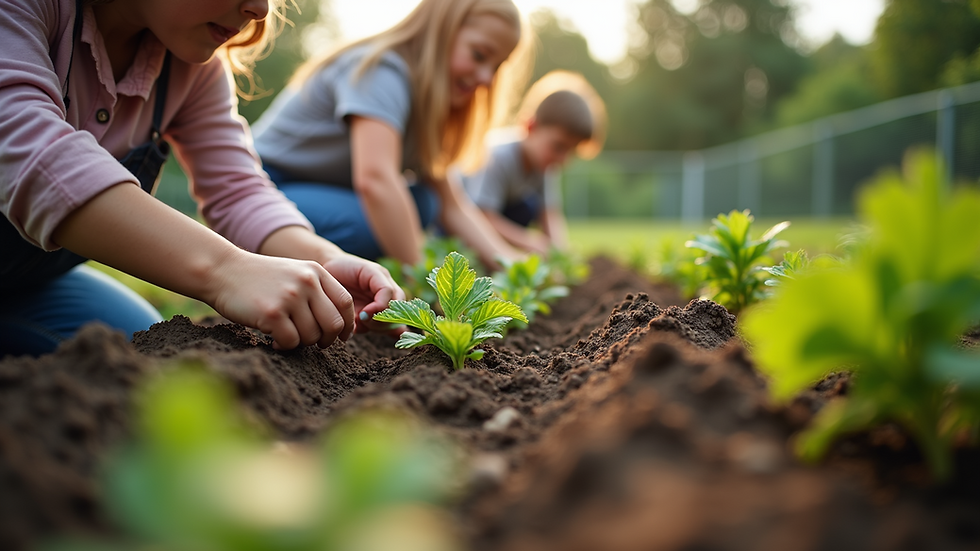Building a Sustainable Future: Key Strategies for School Growth
- Rukiya Deetjen Ruiz
- Feb 6
- 4 min read
In today's world, sustainability is more than just a buzzword. It is a necessity. Schools play a crucial role in shaping the future, and they can lead the way in sustainable practices. By adopting eco-friendly strategies, schools can not only reduce their environmental impact but also foster a culture of sustainability among students. This blog post will explore key strategies for school growth that focus on sustainability, providing practical examples and insights.
Understanding Sustainability in Education
Sustainability in education means integrating environmental, social, and economic considerations into the school system. It involves teaching students about the importance of protecting our planet while also ensuring that schools operate efficiently and responsibly.
By embedding sustainability into the curriculum, schools can inspire students to think critically about their actions and their impact on the world. This approach not only benefits the environment but also prepares students for future challenges.
Creating a Green Curriculum
One of the first steps toward a sustainable school is to develop a green curriculum. This involves incorporating environmental education into various subjects. For example, science classes can focus on ecosystems, while art classes can explore recycling and upcycling projects.
Practical Examples
Project-Based Learning: Schools can implement project-based learning that focuses on real-world environmental issues. For instance, students can work on a project to reduce waste in the school cafeteria.
Field Trips: Organizing field trips to local parks or nature reserves can help students connect with nature and understand the importance of conservation.
By making sustainability a core part of the curriculum, schools can engage students and encourage them to take action.
Implementing Eco-Friendly Practices
Schools can adopt various eco-friendly practices to reduce their carbon footprint. These practices not only benefit the environment but can also lead to cost savings.
Energy Efficiency
LED Lighting: Replacing traditional light bulbs with LED lights can significantly reduce energy consumption.
Smart Thermostats: Installing smart thermostats can help regulate heating and cooling, leading to lower energy bills.
Waste Reduction
Recycling Programs: Implementing a robust recycling program can help reduce waste. Schools can set up bins for paper, plastic, and metal.
Composting: Starting a composting program for food waste can reduce landfill contributions and create nutrient-rich soil for school gardens.
By taking these steps, schools can create a more sustainable environment for students and staff.
Engaging the School Community
Building a sustainable future requires the involvement of the entire school community. Engaging students, teachers, and parents is essential for the success of sustainability initiatives.
Organizing Events
Sustainability Fairs: Hosting a sustainability fair can raise awareness about environmental issues. Students can showcase their projects and share ideas.
Clean-Up Days: Organizing clean-up days at local parks or beaches can foster a sense of community and responsibility.
Encouraging Student Leadership
Empowering students to take the lead on sustainability initiatives can be incredibly effective. Schools can create eco-clubs where students can brainstorm and implement their ideas.
By involving the school community, sustainability becomes a shared goal, leading to greater commitment and success.
Building Green Infrastructure
Investing in green infrastructure is another key strategy for sustainable school growth. This includes designing and constructing buildings that are energy-efficient and environmentally friendly.
Examples of Green Infrastructure
Green Roofs: Installing green roofs can help insulate buildings and reduce stormwater runoff. They also provide a habitat for wildlife.
Rainwater Harvesting: Implementing rainwater harvesting systems can reduce water usage and provide a sustainable water source for landscaping.
By prioritizing green infrastructure, schools can create a healthier environment for learning.
Collaborating with Local Organizations
Partnering with local organizations can enhance sustainability efforts in schools. These collaborations can provide resources, expertise, and support for various initiatives.
Potential Partnerships
Environmental NGOs: Collaborating with local environmental organizations can provide access to educational resources and programs.
Local Businesses: Partnering with local businesses can lead to sponsorships for sustainability projects or donations of materials.
By building these partnerships, schools can expand their reach and impact.
Measuring Success
To ensure that sustainability initiatives are effective, schools must measure their success. This involves setting clear goals and tracking progress over time.
Key Performance Indicators
Energy Consumption: Monitoring energy usage can help schools identify areas for improvement.
Waste Reduction: Tracking the amount of waste generated and recycled can provide insights into the effectiveness of waste reduction programs.
By measuring success, schools can make informed decisions and continuously improve their sustainability efforts.
Inspiring Future Generations
Ultimately, the goal of building a sustainable future in schools is to inspire the next generation. By teaching students about sustainability and providing them with the tools to make a difference, schools can create a lasting impact.
Encouraging Lifelong Learning
Sustainability Workshops: Offering workshops on topics like gardening, renewable energy, or conservation can empower students to take action beyond the classroom.
Community Service Projects: Encouraging students to participate in community service projects can help them understand the importance of giving back and protecting the environment.
By fostering a culture of sustainability, schools can inspire students to become responsible stewards of the planet.
Conclusion: A Collective Journey Towards Sustainability
Building a sustainable future is a collective journey that requires commitment, creativity, and collaboration. Schools have a unique opportunity to lead the way in sustainability, shaping the minds of future generations. By implementing eco-friendly practices, engaging the community, and measuring success, schools can create a lasting impact.
As we move forward, let us remember that every small action counts. Together, we can build a brighter, more sustainable future for all.

